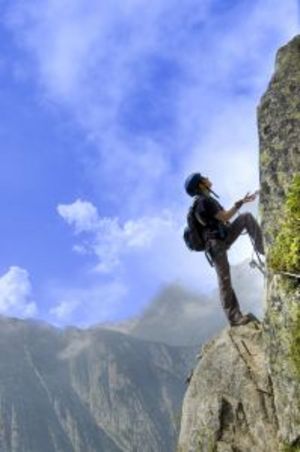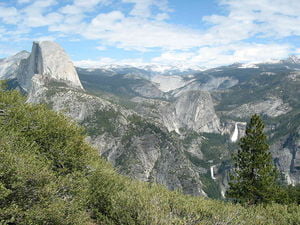There are a lot of conflicting notions out there about the true danger of rock climbing. If we are to believe Hollywood, then you’d better be prepared to die. Your death will either be a quick splat when you connect with the earth a thousand feet below or it will be a slow and painful one as you wait in vain to be rescued. Knots will come undone, ropes will break, and your gear will always, without fail, pull out of the rock. And don’t forget your bullet proof vest (or dueling banjo), ’cause them inbred red necks will be a wait’n fer ya to shoot you off the rock.
If we listen to a number of climbing advocates, then rock climbing is safer than your morning commute. Now, the consequences of a serious accident can be just as deadly in both cases. A mashed up pulp in a car looks about the same as a mashed up pulp at the base of a cliff. However, rock climbing demands more skill and focus on your part than driving. Case in point: cell phones. If you’re not using a cell phone while driving, then you’re just plain weird. Although climbers may be using their cell phones while waiting on a ledge, very few can do it while actually climbing. Ya need both of those hands, especially if the climb is even moderately difficult. In short, you can get away with a lot more while driving than when rock climbing. I challenge any climber out there, to brush their teeth, read a book, put on make up, pluck their eyebrows, drink hot coffee, eat a big mac, pet the dog, and fight with their kids while doing a rock climb.
To put it another way, it’s a lot easier to screw up when you’re climbing. Therefore, rock climbing is not safer than your morning commute. I’ve had one serious car accident happen to me and also have had one serious climbing accident. I smashed up my car because I was stupid. I was giving my driving almost no focus at all. I smashed up my leg when rock climbing, because while trying to execute some difficult climbing moves, one detail escaped my notice (my rope was between my legs when it shouldn’t have been). This complicated my fall when I failed to do the moves correctly.
If we are to believe a lot of climbing articles and videos, then free soloing (rock climbing without a rope) is just another flavor of rock climbing. Unless you know how to fly, your options are limited when falling un roped. If the fall is high enough or the landing messy enough, you will die. I’ve seen what a person looks like after only a 40 foot fall to the ground (twitching limbs, foaming mouth). I’m not knocking free soloing. There will always be intense individuals out there with an insatiable appetite for adrenaline. These are the fighter pilots and astronauts of the world. Our species actually needs this type of individual. They’re not crazy. A truly crazy person (like a schizophrenic say) wouldn’t be able to pull it off. The problem is in the laid back way that free soloing is presented in a lot of climbing literature. More thought should be given to its presentation, especially to beginner climbing wannabe’s. The tricky part of this is that there are some dare devils who are superbly gifted athletes, but there are many more who aren’t. Parents are concerned about how religion, or evolution, or sexuality is presented in the books that their kids read. If your teenager has taken up climbing, you should be concerned about their attitude toward free soloing. When I started climbing, I thought that free soloing was just another form of climbing that had a fair amount of social validation. So, the “me too” reflex kicked in and I had to try it too.
So, is rock climbing safe? The answer is no, it’s not. Well, how dangerous is it then? That depends on what you’re doing. If you’re climbing indoors and you and your partner are experienced and conscientious, it’s hardly dangerous at all. The same is true if you are climbing top roped outdoors. However, you have to set up your own anchors outdoors, so more skill and good judgement is required to climb safely. People above you can accidentally knock rocks down. That is one danger that is absent from indoor rock climbing. Fortunately the law of statistics are on your side and more likely than not, the rock will miss you. Your odds are improved further if the person above yells out a warning and you take notice. It also wouldn’t hurt to wear a helmet. I would say that if you confined your climbing to the indoors or to outdoor top roping, then you’ve got a fairly safe hobby. It’s probably safer than bicycling long distances on the open road.
The potential dangers increase when you start lead climbing multi-pitch rock climbs outdoors. There are a lot more objective dangers to contend with when you’re perched up on a 1000 foot rock face. Up to a point, these dangers can be neutralized with skill, good judgement, and experience. The catch-22 of this is that you need to be exposing yourself to these potential dangers on a consistent basis in order to maintain the mastery required to neutralize these dangers. So, on the one hand, the law of statistics must catch up with you if you constantly expose yourself to danger. On the other hand, your increased competence diminishes this danger.
If your climbing hobby turns into a climbing career, then over time, some of the Hollywood scenarios mentioned above can actually come to pass. The more ambitious your climbing is and the more extensive your climbing travels become, the greater the chance of freakish things happening to you. In my 20 years of active climbing, I’ve had near misses with falling rock, ice, climbing gear, and yes, people (he was tied on to a rope). I’ve been attacked by angry hornets, retreated from lighting storms, and had my climbing gear pop out of the rock at the most inopportune times. I have participated in the rescue of an injured climber and I’ve been injured and rescued myself. I’ve had to jam my hands into a crack with nesting bats inside. The climb was overhung and jamming my hands into that crack was the only way to proceed. I was bitten by a baby rattle snake. I’ve watched a rock the size of a small car fall 800 feet before exploding like bomb when it hit the ground.
One of my friends was climbing in the Wind River Range and was caught in a very intense lighting storm. He said that his ice axe and the metal equipment in his back pack were vibrating and humming. All he could do was carry on and hope for the best. A friend of a friend of mine, died while rock climbing in Nevada. His protection gear ripped out of the sandstone rock. He fell all the way to the ground. He was used to climbing on New Hampshire granite which is usually more solid than sandstone. Greater care is required when placing gear in sandstone rock. He was a Hewlett Packard engineer.
Some of the climbing greats that I’ve read about over the years are dead now (and they didn’t die from old age).
So the good news out of all of this grim stuff is that you get to choose your level of risk exposure. You can do safe top rope climbing or you can attempt a climbing career (or anything in between). A climbing career doesn’t necessarily mean that you are making a living from climbing. It means that you find the adventurous lifestyle so intoxicating that you end up making some significant compromises with respect to other aspects of your life. You can’t have true adventure with out some risk. It’s part of the definition. What you want to avoid is getting into a situation that you didn’t bargain for. When you expose yourself to danger, it should be a deliberate and calculated act with full knowledge of what you are dealing with. You do this deliberately because of a desire to test your skills and abilities. Now, not every climb has to be like this. I find that when I’m constantly testing myself with no let up, it gets to be too stressful, so I’ll back off on the pace and either do some easy, pleasant climbs or just do something else. Sometimes it can feel as if the rock pitches above me are like a series of stressful interviews or final exams. This can happen if I’m doing all of the lead climbing. When I find myself looking enviously at the tourists below who are looking up at me, then I know that it’s time to slow the pace down a little. This vacation from climbing doesn’t last long, just the sight of the tiny little figures of climbers on a rock face is enough for me to want to go back up there.


